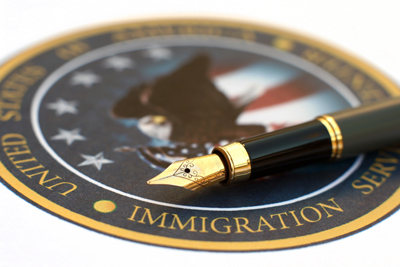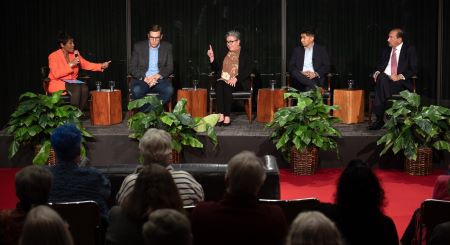Immigration Reform Ideas for the New Speaker
Fixing our legal immigration system is the key to stopping unauthorized immigration and allowing our economy to attract the workers it demands.
 Paul Ryan (R-Wis.) began his term as the youngest Speaker of the House of Representatives in living memory by tweeting “[w]e are not settling scores. We are wiping the slate clean.” The policy slate that needs the deepest sterilization is immigration. Speaker Ryan has been supportive of moderate immigration reform in the past, so here are some new conservative immigration reform ideas to help him get the ball rolling.
Paul Ryan (R-Wis.) began his term as the youngest Speaker of the House of Representatives in living memory by tweeting “[w]e are not settling scores. We are wiping the slate clean.” The policy slate that needs the deepest sterilization is immigration. Speaker Ryan has been supportive of moderate immigration reform in the past, so here are some new conservative immigration reform ideas to help him get the ball rolling.
Immigrant use of welfare benefits is a great place to start. Non-citizens and unauthorized immigrants have access to few means-tested welfare benefits under current law. President Obama’s Justice Department actually sued the state of Pennsylvania for giving Medicaid, Temporary Assistance to Needy Families and food stamps to a handful of unauthorized immigrants — winning a $48.8 million settlement in early 2015.
Poor immigrant individuals are less likely to use means-tested welfare than poor native-born Americans. When eligible poor immigrants do use those programs, the dollar value of the benefits they consume also tends to be lower.
However, any use of welfare by non-citizens is a drain on taxpayers that could easily be remedied by building an even higher wall around the welfare state. A 2013 paper I wrote with Sophie Cole entitled “Building a Wall around the Welfare State, Instead of the Country,” lays out the economic and fiscal benefits of further restricting welfare use, explains why the public is worried about immigrant welfare use, and identifies the specific statutes that govern immigrant eligibility for benefits.
Fixing our legal immigration system is the key to stopping unauthorized immigration and allowing our economy to attract the workers it demands. However, most federal visas get so hopelessly bogged down in regulations that they become practically unusable. Speaking of the federal H-2A visa for agricultural workers, Elaine Chao, President George W. Bush’s secretary of Labor, said that “Many who have tried [the H-2A visa] report such bad experiences that they stopped using it altogether.”
Although there has been an uptick in use of the H-2A visas recently, a program which is currently regulated by four different federal agencies, the visa remains underutilized due to bureaucratic ossification. Worse, there are no visas available for yearlong work in almost all occupations and thus little labor market flexibility.
The way around growing visa complexity and restrictions is to allow states to run their own visa systems parallel to the federal government’s. As Brandon Fuller and Sean Rust wrote in their Cato Institute policy analysis proposing state-based visas, introducing federalism to America’s legal migration system will allow states to get the actual workers they demand and experiment with different legal regimes.
Allowing states to run their own migrations systems is not an untried proposal; Canada and Australia have similar successful programs. Instead of inviting just workers at any skill level or education, states could also set up visas for entrepreneurs and smaller-scale investors — categories that don’t currently exist. A state-based visa could also prompt experimentation on enforcement techniques and strategies. American states test different policies like welfare reform, gun laws and tax regimes — it’s time they do it with migration, too.
There is considerable demand on the state level for this type of program. In 2015, both Texas and California considered asking the federal government for permission to experiment with their own migration programs. In previous years, at least 14 other states have considered setting up their own migration systems, asking the federal government for permission to do so, or lobbied for a special allotment. It’s time the federal government allows states to do this — at least as a pilot program.
No discussion of immigration reform ideas is complete without addressing the unauthorized immigrant population. Although their numbers have stabilized around 11.5 million, they need some sort of legalization. Conservatives are skeptical of a blanket amnesty for obvious reasons, so why not try a multi-tiered legalization? Instead of giving most unauthorized immigrants a path to citizenship, there should be different paths toward legal status and the migrant should choose for him or herself.
The first tier can be very cheap and lead to a permanent renewable work permit. It won’t ever allow welfare benefits or family sponsorship, but it will allow the migrant to work legally, own property, get a drivers license, and otherwise participate in American life. The second tier can be a more expensive path to a permanent green card that doesn’t need renewal. It can allow partial family sponsorship, deny welfare, but it cannot lead to citizenship for the formerly illegal migrant himself.
The third step should lead to citizenship, but it should be the most expensive and difficult: mirroring the Senate’s legalization path in its 2013 bill. Most unauthorized immigrants will not choose this path, but the option of citizenship will be open to those who want it the most — at a price. Only 45 percent of those legalized under the 1986 Reagan amnesty actually chose to become citizens. Instead of the government creating a one-size-fits-all legalization program, a tiered system should be created that allows the migrants to choose for themselves.
The face of immigration is changing without Congress’s involvement. Latin American immigration is falling, while that from Asia is rising rapidly. These three new policy ideas would allow more immigration flexibility by incorporating federalist principles, limiting welfare and creating options for legalization. Importantly, they appeal to the heart and mind of American conservatism. Speaker Ryan will have some difficult immigration challenges ahead of him; these ideas can help him get ahead of them.








